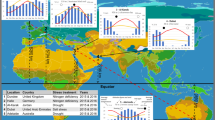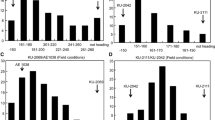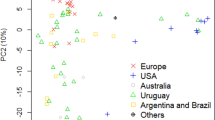Abstract
Barley can be classified into three major agronomic types, based on its seasonal growth habit (SGH): spring, winter and alternative. Winter varieties require exposure to vernalization to promote subsequent flowering and are autumn-sown. Spring varieties proceed to flowering in the absence of vernalization and are sown in the spring. The ‘alternative’ (also known as ‘facultative’) SGH is only loosely defined and can be sown in autumn or spring. Here, we investigate the molecular genetic basis of alternative barley. Analysis of the major barley vernalization (VRN-H1, VRN-H2) and photoperiod (PPD-H1, PPD-H2) response genes in a collection of 386 varieties found alternative SGH to be characterized by specific allelic combinations. Spring varieties possessed spring loci at one or both of the vernalization response loci, combined with long-day non-responsive ppd-H1 alleles and wild-type alleles at the short-day photoperiod response locus, PPD-H2. Winter varieties possessed winter alleles at both vernalization loci, in combination with the mutant ppd-H2 allele conferring delayed flowering under short-day photoperiods. In contrast, all alternative varieties investigated possessed a single spring allele (either at VRN-H1 or at VRN-H2) combined with mutant ppd-H2 alleles. This allelic combination is found only in alternative types and is diagnostic for alternative SGH in the collection studied. Analysis of flowering time under controlled environment found alternative varieties flowered later than spring control lines, with the difference most pronounced under short-day photoperiods. This work provides genetic characterization of the alternative SGH phenotype, allowing precise manipulation of SGH and flowering time within breeding programmes, and provides the molecular tools for classification of all three SGH categories within national variety registration processes.



Similar content being viewed by others
References
Bentley AR, Jensen EF, Mackay IJ, Hönicka H, Fladung M, Hori K, Yano M, Mullet JE, Armstead IP, Hayes C, Thorogood D, Lovatt A, Morris R, Pullen N, Mutasa-Göttgens E, Cockram J (2013) Flowering time. In: Cole C (ed) Genomics and breeding for climate-resilient crops, vol 2. Springer, Berlin, pp 1–67
Casao MC, Igartura E, Karsai I, Lasa JU, Gracia MP, Casas AM (2011) Expression analysis of vernalization and day-length response genes in barley (Hordeum vulgare L.) indicates that VRNH2 is a repressor of PPDH2 (HvFT3) under long days. J Exp Bot 62:1939–1949
Cockram J, Jones H, Leigh FJ, O’Sullivan D, Powell W, Laurie DA, Greenland AJ (2007a) Control of flowering time in temperate cereals: genes, domestication and sustainable productivity. J Exp Bot 58:1231–1244
Cockram J, Chiapparino E, Taylor SA, Stamati K, Donini P, Laurie DA, O’Sullivan DM (2007b) Haplotype analysis of vernalization loci in European barley germplasm reveals novel VRN-H1 alleles and a predominant winter VRN-H1/VRN-H2 multi-locus haplotype. Theor Appl Genet 115:993–1001
Cockram J, Mackay IJ, O’Sullivan DM (2007c) The role of double-stranded break repair in the creation of phenotypic diversity at cereal VRN1 loci. Genetics 177:1–5
Cockram J, White J, Leigh FJ, Lea V, Mackay IJ, Laurie DA, Powell W, O’Sullivan DM (2008) Association mapping of partitioning loci in barley. BMC Genet 9:16
Cockram J, Norris C, O’Sullivan DM (2009) PCR-based markers diagnostic for spring and winter seasonal growth habit in barley. Crop Sci 49:403–410
Cockram J, Howells R, O’Sullivan DM (2010a) Segmental duplication harbouring group IV CONSTANS-like genes in cereals. Genome 53:231–240
Cockram J, White J, Zuluaga DL, Smith D, Comadran J, Macaulay M, Luo Z, Kearsey MJ, Werner P, Harrap D et al (2010b) Genome-wide association mapping to candidate polymorphism resolution in the unsequenced barley genome. Proc Natl Acad Sci USA 107:21611–21616
Cockram J, Jones H, O’Sullivan DM (2011) Genetic variation at flowering time loci in wild and cultivated barley. Plant Genet Res Charact Utili 9:264–267
Cockram J, Thiel T, Steuernagel B, Stein N, Taudien S, Bailey PC, O’Sullivan DM (2012a) Genome dynamics explain the evolution of flowering time CCT domain gene families in the Poaceae. PLoS ONE 7:e45307
Cockram J, Jones H, Norris C, O’Sullivan DM (2012b) Evaluation of diagnostic molecular markers for DUS phenotypic assessment in the cereal crop, barley (Hordeum vulgare ssp. vulgare L.). Theor Appl Genet 125:1735–1749
Distelfeld A, Tranquilli G, Li C, Yan L, Dubcovsky J (2009) Genetic and molecular characterization of the VRN2 loci in tetraploid wheat. Plant Physiol 149:245–257
Faure S, Higgins J, Turner A, Laurie DA (2007) The FLOWERING LOCUS-T-like family in barley (Hordeum vulgare). Genetics 176:599–609
Fjellheim S, Boden S, Trevaskis B (2014) The role of seasonal flowering responses in adaptation of grasses to temperate climates. Front Plant Sci 4:431
Francia E, Rizza F, Cativelli L, Stanca AM, Busconi M, Fogher C, Stockinger EJ, Pecchioni N (2007) Fine mapping of a HvCBF gene cluster at the frost resistance locus Fr-H2 in barley. Theor Appl Genet 115:1083–1091
Fricano A, Rizza F, Faccioli P, Pagani D, Pavan P, Stella A, Rossini L, Piffanelli P, Cattivelli L (2009) Genetic variants of HvCBF14 are statistically associated with frost tolerance in an European germplasm collection of Hordeum vulgare. Theor Appl Genet 119:1335–1348
Fu D, Szűcs P, Yan L, Helguera M, Skinner JS, von Zitzewitz J, Hayes PM, Dubcovsky J (2005) Large deletions within the first intron in VRN-1 are associated with spring growth habit in barley and wheat. Mol Genet Genomics 273:54–65
Hemming MN, Fieg S, Peacock WJ, Dennis ES, Trevaskis B (2009) Regions associated with repression of the barley (Hordeum vulgare) VERNALIZATION1 gene are not required for cold induction. Mol Genet Genomics 282:107–117
Jones H, Civan P, Cockram J, Leigh FJ, Smith LMJ, Jones MK, Charles MP, Molina-Cano J-L, Powell W, Jones G, Brown TA (2011) Evolutionary history of barley cultivation in Europe revealed by genetic analysis of extant landraces. BMC Evol Biol 11:320
Jones H, Norris C, Cockram J, Lee D (2013) Variety protection and plant breeders’ rights in the ‘DNA era’. In: Lübberstedt T, Varshney RK (eds) Diagnostics in plant breeding. Springer, Netherlands, pp 396–402
Karsai I, Szűcs P, Mészáros K, Filichkina T, Hayes PM, Skinner JS, Láng L, Bedö Z (2005) The Vrn-H2 locus is a major determinant of flowering time in a facultative X winter growth habit barley (Hordeum vulgare L.) mapping population. Theor Appl Genet 110:1458–1466
Knox AK, Dhillon T, Cheng H, Tondelli A, Pecchioni N, Stockinger EJ (2010) CBF gene copy number variation at Frost Resistance-2 is associated with levels of freezing tolerance in temperate-climate cereals. Theor Appl Genet 121:21–35
Laurie DA, Pratchett N, Bezant JH, Snape JW (1995) RFLP mapping of five major genes and eight quantitative trait loci controlling flowering time in a winter x spring barley (Hordeum vulgare L.) cross. Genome 38:575–585
Muterko A, Balashova I, Cockram J, Kalendar R, Sivolap Y (2014) The wheat vernalization response allele Vrn-D1s is caused by DNA transposon insertion in the first intron. Plant Mol Biol Rep. doi:10.1007/s11105-014-0750-0
Oliver SN, Finnegan EJ, Dennis ES, Peacock WJ, Trevaskis B (2009) Vernalization-induced flowering in cereals is associated with changes in histone methylation at the VERNALIZATION1 gene. Proc Natl Acad Sci USA 106:8386–8391
Oliver SN, Deng W, Casao C, Trevaskis B (2013) Low temperatures induce rapid changes in chromatin state and transcript levels of the cereal VERNALIZATION1 gene. J Exp Bot 64:2413–2422
Szűcs P, Skinner J, Karsai I, Cuesta-Marcos A, Haggard KG, Corey AE, Chenn THH, Hayes PM (2007) Validation of the VRN-H2/VRN-H1 epistatic model in barley reveals that intron length variation at VRN-H1 may account for a continuum of vernalization sensitivity. Mol Genet Genomics 277:249–261
Thompson JD, Higgins DG, Gibson TJ (1994) CLUSTAL W: improving the sensitivity of progressive multiple sequence alignment through sequence weighting, position specific gap penalties and weight matrix choice. Nucleic Acids Res 22:4673–4680
Trevaskis B (2010) The central role of the VERNALIZATION1 gene in the vernalization response of cereals. Funct Plant Biol 37:479–487
Trevaskis B, Hemming MN, Peacock WJ, Dennis ES (2006) HvVRN2 responds to day length, whereas HvVRN1 is regulated by vernalization and developmental status. Plant Physiol 140:1397–1405
Turner A, Beales J, Faure S, Dunford RP, Laurie DA (2005) The pseudo-response regulator Ppd-H1 provides adaptation to photoperiod in barley. Science 310:1031–1034
Turner AS, Faure S, Zhang Y, Laurie DA (2013) The effect of day-neutral mutations in barley and wheat on the interaction between photoperiod and vernalization. Theor Appl Genet 126:2267–2277
von Zitzewitz J, Szűcs P, Dubcovsky J, Yan L, Francia E, Pecchioni N, Casas A, Chen THH, Hayes PM, Skinner JS (2005) Molecular and structural characterization of barley vernalization genes. Plant Mol Biol 59:449–467
von Zitzewitz J, Cuesta-Marcos A, Condon F, Castro AJ, Chao S, Corey A, Filichkin T, Fisk SP, Gutierrez L, Haggard K et al (2011) The genetics of winterhardiness in barley: perspectives from genome-wide association mapping. Plant Genome 4:76–91
Xue W, Xing Y, Weng X, Zhao Y, Tang W et al (2008) Natural variation in Ghd7 is an important regulator of heading date and yield potential in rice. Nat Genet 40:761–767
Yan L, Loukoianov A, Blechl A, Tranquilli G, Ramakrishna W, SanMiguel P, Bennetzen JL, Echenique V, Dubcovsky J (2004) The wheat VRN2 gene is a flowering repressor downregulated by vernalization. Science 303:1640–1644
Acknowledgments
This work was funded by Defra Grant 2007J.
Author information
Authors and Affiliations
Corresponding author
Ethics declarations
Author contributions
J.C., C.N. and D.O.S. devised research, J.C., E.S., R.H. undertook experimental work, J.C. analysed data and wrote the manuscript, all authors reviewed the manuscript.
Electronic supplementary material
Below is the link to the electronic supplementary material.
Rights and permissions
About this article
Cite this article
Cockram, J., Horsnell, R., Soh, Eh. et al. Molecular and phenotypic characterization of the alternative seasonal growth habit and flowering time in barley (Hordeum vulgare ssp. vulgare L.). Mol Breeding 35, 165 (2015). https://doi.org/10.1007/s11032-015-0359-5
Received:
Accepted:
Published:
DOI: https://doi.org/10.1007/s11032-015-0359-5




